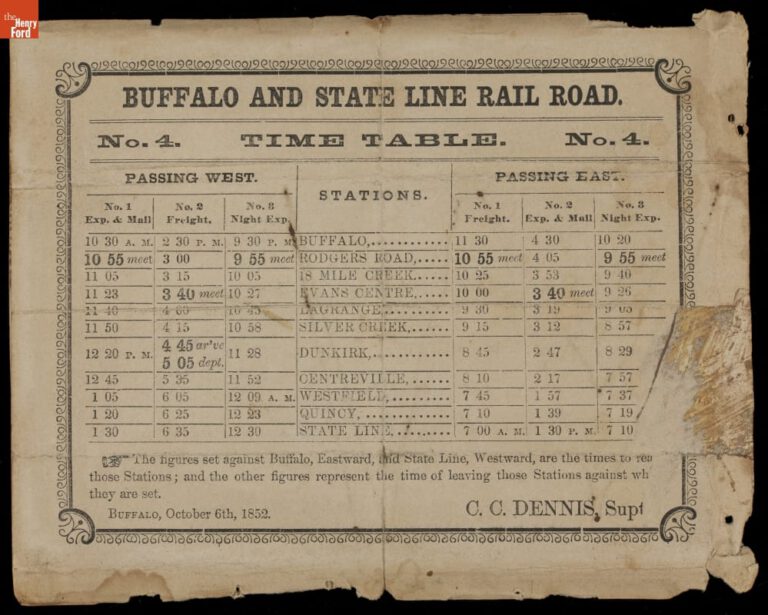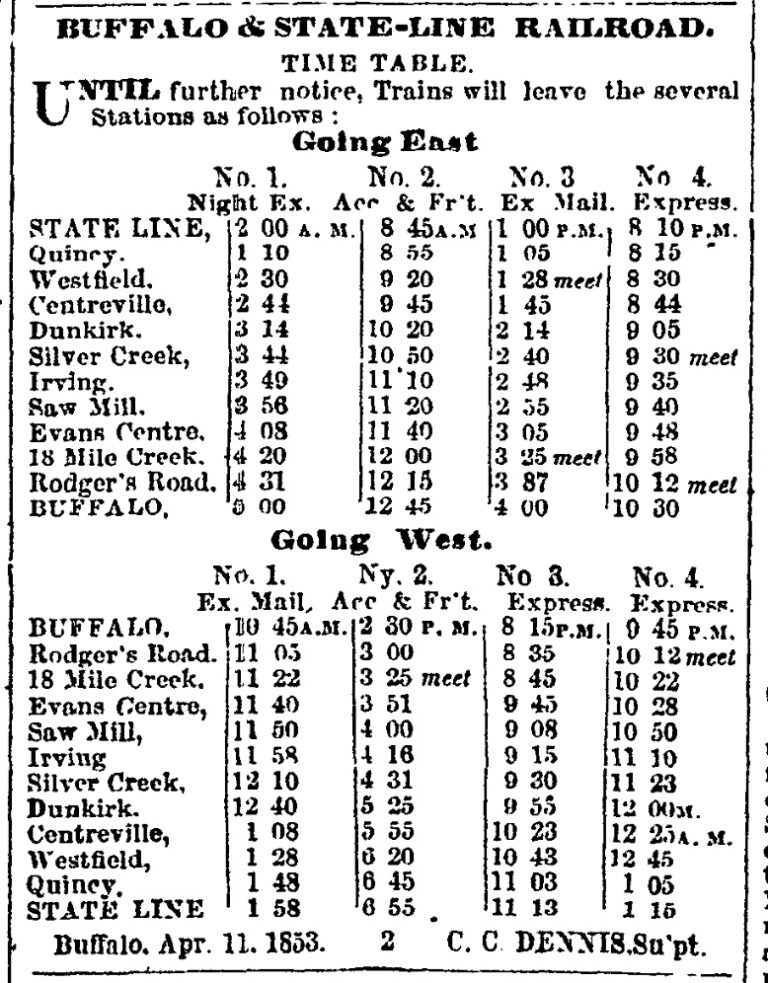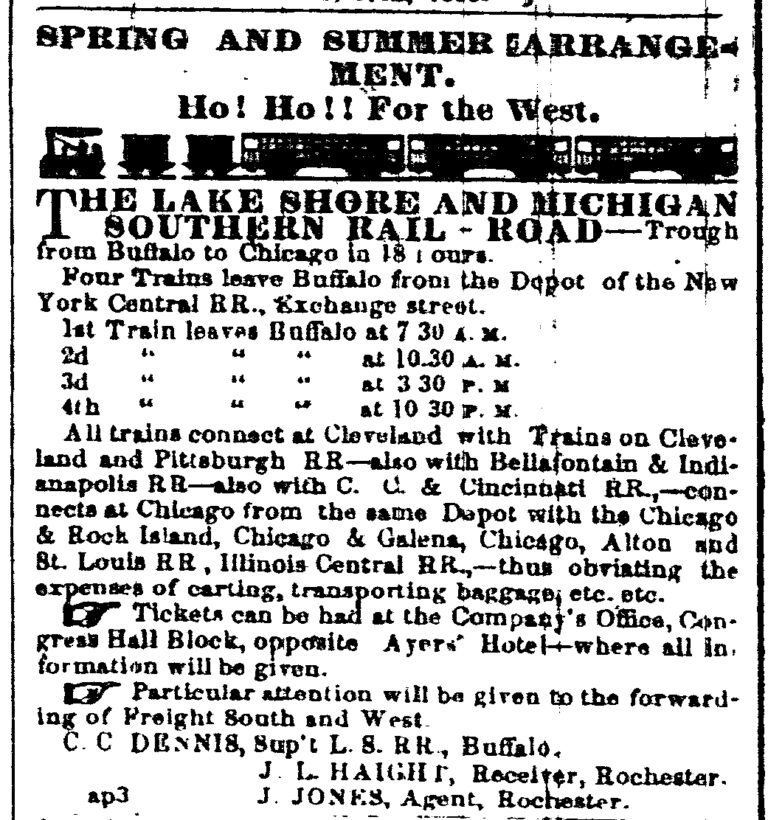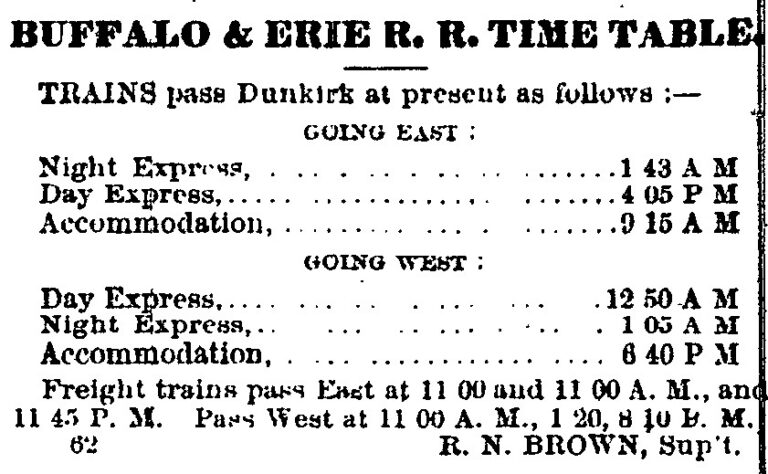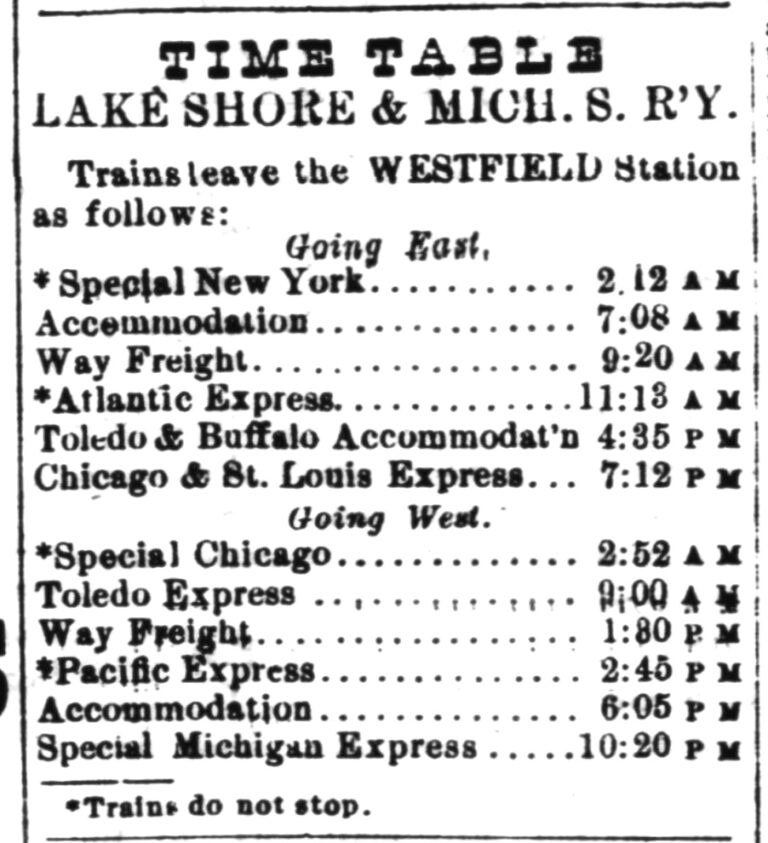
History
As with most railroads, the Lake Shore and Michigan Southern (LS&MS) Railway was the consolidation of many smaller roads. In New York State, the majority of the LS&MS route and track came from the Buffalo and Erie Railroad and its predecessors, including the Buffalo and State Line Railroad and Dunkirk and State Line Railroad.
Dunkirk and State Line Railroad
The Dunkirk and State Line Railroad was organized in 1850 by a group affiliated with the New York and Erie Railroad (later the Erie Railroad) to build a wide-gauge (6 feet) railroad from a connection with the New York and Erie at Dunkirk to the Pennsylvania-New York state line. There it would connect with the Erie and Northeast Railroad, which was chartered in 1842 in Pennsylvania to build from the city of Erie to the state line.
Buffalo and State Line Railroad
The Buffalo and State Line (B & SL) Railroad was organized by a group affiliated with the New York Central Railroad and was incorporated on October 13 , 1849 to build a standard-gauge line from Buffalo, through Fredonia, to the Pennsylvania state line. The result would have been two parallel, competing lines of different gauges running along the shores of Lake Erie between Dunkirk and the state line. At the time, the New York Central was stronger than the Erie and by 1851 an agreement has been reached in which the Dunkirk and State Line would be abandoned and the B & SL would be rerouted to Dunkirk, where it would connect with the New York and Erie. As part of the compromise, the line would be built using the “Ohio Gauge” of 4-feet 10-inches.
The Buffalo and State Line opened on January 1, 1852 from Dunkirk to the Pennsylvania state line and a connection with the Erie and Northeast Railroad. It completed the 40 mile line from Dunkirk to Buffalo on February 22 of the same year.
Buffalo and Erie Railroad
An 1878 Poor’s Manual noted that the Buffalo and State Line and the Erie and Northeast railroads were operated under contract as one road starting in November 19 , 1853 and references from as early as 1855 refer to the Buffalo and Erie Railroad, including this August 1856 news clipping:

The 1860 gazetteer below provides a little history of the Buffalo and State Line and incorrectly states that the B&SL purchased the North East Railroad. In reality, the B&SL leased the Erie and North East Rail Road in 1857.

A special act of the legislature of New York passed April 13 , 1857 authorized the Buffalo and State Line to lease the Erie and North East. On May 15 , 1867 the two railroad companies were formally consolidated under the name Buffalo and Erie Railroad.
Lake Shore and Michigan Southern
In August 1869 the Lake Shore and Michigan Southern Railway absorbed the Buffalo and Erie, along with other railroads, giving the company a continuous line from Buffalo to Chicago.
Around 1877 the New York Central and Hudson River Railroad gained the majority of the stock in the Lake Shore and Michigan Southern. While nominally independent, the line was operated in conjunction with the New York Central. This lasted until 1914 when the New York Central and Hudson River Railroad merged with the Lake Shore and Michigan Southern Railway to form the New York Central Railroad.
The Chautauqua County history mentions “The facilities for travel increased rapidly … to 1892, when the Dunkirk & Silver Creek railroad was built, a double track line, afterwards incorporated into the Lake Shore & Michigan Southern.” This is a reference to the Silver Creek and Dunkirk Railway, which was incorporated in 1890 and built 8.71 miles of track between the two towns. This was a paper railroad – the LS&MS did the actual construction of the line and merged the Silver Creek and Dunkirk into the LS&MS on June 29, 1894. The end result was that the LS&MS had a double-track line between those towns.
Setting the Gauge of the Line
The Erie and North East Railroad was incorporated in Pennsylvania in 1842 to build from the city of Erie to the New York State line. The Erie and North East and Buffalo and State Line railroads cooperated closely. The following from the 1904 “Centennial History of Chautauqua County” describes the challenges of setting a common gauge (distance between the rails) for the two companies:
Within a year after the New York & Erie was completed, another important railroad was in operation through Northern Chautauqua — the Buffalo & State Line. About that time a road was organized in Erie to be built from Erie to the state line to connect with the Buffalo & State Line Road. This road was of six foot gauge. The roads in New York State were of four feet ten inch gauge. By the laws of Pennsylvania, at that time, all roads entering Erie from the east were to be six feet or four feet eight and one-half inch gauge and all from the west four feet ten inches. The difference in gauges was a serious inconvenience to the Railroad Companies and to the public and on the 17th of November, 1853, a contract was entered into by which the road between the state line and Erie was to alter its track to four feet ten inches, making a uniform gauge from Buffalo to Cleveland. The change was effected in two months and completed February 1, 1854, when the first through train under the new arrangement passed through Chautauqua County from the East.
This led to friction with the residents of Erie, Pennsylvania, because companies in the city made good money transferring freight from trains of one gauge to trains using another. Some individuals tore out the tracks in the city, but eventually the standard was accepted. See Edwin Mott’s “The War of the Gauges” and Jerry D’Aurora and Jerry Skrypzak’s “Nickel Plate in the ‘Erie Triangle‘” for a much more detailed look at this issue.
I don’t know when the 4 feet 10-inch gauge was changed to the standard 4 feet 8 1/2 inches, but an 1868 Poor’s Railroad Manual still listed it as 4 feet 10-inches. An 1872 Poor’s manual for the Lake Shore and Michigan Southern lists the gauge as “W. of Toledo, 4 feet 8 1/2 inches; and E. of Toledo, 4 feet 9 1/2 inches.”
Stations
Buffalo (DL&W Station) * West Seneca * Blasdell * Bay View * Athol Springs * Wanakah * Lake View * North Evans * Derby * Angola / Evans Center * Farnham / Saw Mill * Irving * Silver Creek * Waites Crossing * Dunkirk * Van Buren * Brocton * Portland * Westfield * Ripley Crossing * Ripley
More details
| Distance from Chicago | Station |
|---|---|
| 540 536 534 532 531 528 526 525 523 518 514 512 508 505 500 495 491 489 482 487 475 | Buffalo (DL&W Station) West Seneca Blasdell Bay View Athol Springs Wanakah Lake View North Evans Derby Angola Farnham Irving Silver Creek Waites Crossing Dunkirk Van Buren Brocton Portland Westfield Ripley Crossing Ripley |
Clippings
Locomotive Photographs
Maps
Timetables
Learn More
- The Chautauqua History Company. “Centennial History of Chautauqua County, Volume 1.” Jamestown, NY. 1904.
- D’Aurora, Jerry and Skrypzak, Jerry. “Nickel Plate in the ‘Erie Triangle“”. Nickel Plate Road Magazine, Fall 2015.
- Downs, John Phillips and Hedley, Fenwick. “History of Chautauqua County New York and its People, Volume 1“
- Wikipedia. “Lake Shore and Michigan Southern Railway“
- Wikipedia. “Wikipedia:WikiProject Trains/ICC valuations/New York Central Railroad“


